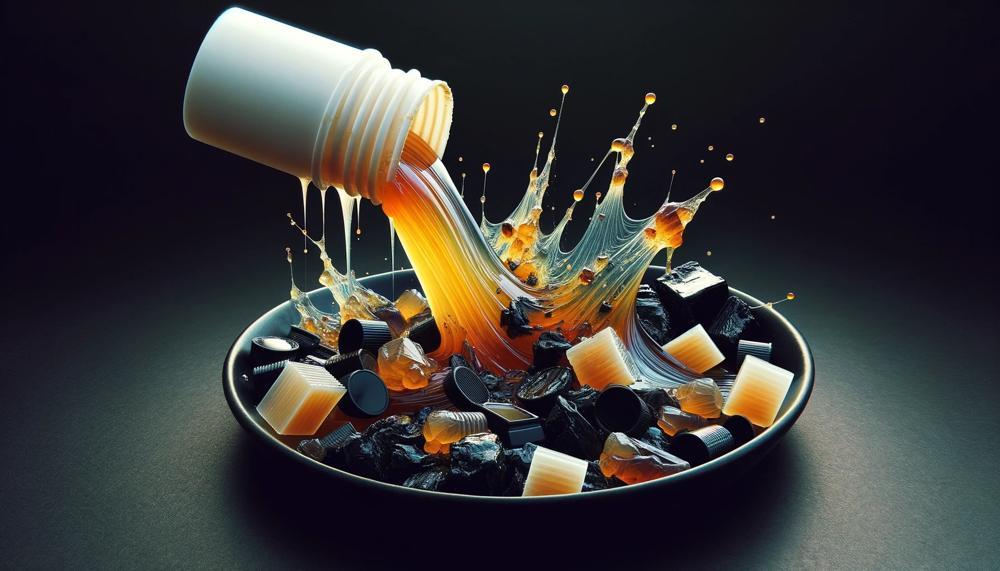Taking up resin making opens up a world of inventiveness and imagination. Still, knowing your way around resin disposal is just as important as being an expert in the field. If we treat this sticky buddy improperly, it might endanger both our personal safety and the environment.
This page serves as your reference to safe and environmentally friendly resin disposal techniques, helping you to avoid the sometimes ambiguous and misinterpreted recommendations.
So, how do you dispose of resin properly?
Here are some steps for disposing of resin:
- Protect yourself: Wear nitrile gloves, protective glasses, and a respirator.
- Pour into a container: Pour a small amount of resin into a clear, resin-safe container.
- Expose to sunlight: Leave the container in direct sunlight for 1–10 days.
- Dispose of: Throw away the cured resin and container as household waste.
You can also add liquid resin to your chemical waste stream. Do not pour liquid or partially cured resin or solvent into drains or dispose of it as household waste.
You can also give your resin to a professional waste disposal service.
Let’s start.
Contents
- 1 How To Dispose Of Resin Properly?
- 2 Understanding the Dangers of Improper Resin Disposal
- 3 Handling Resin Kits Like Other Chemicals in the Home
- 4 Guidelines for Packaging and Labeling Resin for Waste Collection
- 5 Utilizing Safety Data Sheets (SDS) for Safe Disposal Methods
- 6 Tips for Using Up All Contents of a Resin Kit Before Disposal
- 7 How to Dispose of Mistakes Made with Resin
- 8 Conclusion
How To Dispose Of Resin Properly?
Disposing of resin properly not only tidies up your space but also guards our planet against harmful impacts.
Here’s how you can dispose of resin in an environmentally-friendly and safe manner, especially important during seasonal clear-outs like New Year’s cleaning.
Identify the Resin Type
Firstly, pinpoint the resin you’re dealing with. Whether it’s polyethylene, polypropylene, or polystyrene, each has its path towards disposal.
Can It Be Recycled?
Check if the resin is recyclable. Polyethylene and polypropylene often are. Recycling them conserves resources and reduces landfill waste.
For Non-Recyclable Resin
If recycling’s off the table, consider these disposal methods:
| Incineration | Releases chemicals, use as a last resort | Contributes to air pollution |
| Landfill | Takes ages to decompose, potential for toxic leakage | Designed to safely contain waste |
| Pyrolysis | Heats resin without oxygen, breaking it down | Reduces landfill waste, generates fuel or new materials |
Handle and Transport with Care
Avoid environmental harm by preventing spills and sealing resin in containers during transportation.
Follow Local Guidelines
Adhere to any disposal regulations or guidelines from local authorities to ensure responsible disposal.
Understanding the Dangers of Improper Resin Disposal
When it comes to getting rid of resin the wrong way, it’s not just about making a mess; it’s about stirring up a storm that could lash out at our planet and our health for ages.
Imagine a sticky web, not just trapping bugs but weaving into the very fabric of our earth and air, leaking nasties that should have never seen the light of day.
The Unseen Hazards Lurking in Our Waste
| Aspect | Environmental Impact | Human Health Risk |
| Soil and Water Contamination | Leaches poison into earth and streams, turning lush lands barren and waters toxic. | Turns drinking water into a cocktail of chemicals, ushering in ailments from nausea to cancer. |
| Air Pollution | Sends up clouds of toxic fumes, turning blue skies into a murky haze. | Makes every breath a gamble, risking respiratory woes and dizzy spells. |
| Wildlife Impact | Transforms habitats into wastelands, pushing species to the brink and beyond. | Indirectly affects human food sources, threatening our health through the food chain. |
The Poison We Can’t See
Resin might be out of sight once we toss it out, but it sure doesn’t skip out on leaving its mark. It seeps and creeps into nooks and crannies of our environment, from the ground beneath our feet to the water we drink and the air we breathe.
It’s a silent but steady drip of doom, dripping toxins like styrene and toluene, which aren’t just hard to pronounce—they’re hard on our health and our home, Earth.
A Cry for Care
Handling resin with care ain’t just for those in lab coats or wielding power tools. It’s on all of us to keep this sticky foe from sticking our planet and our people with lasting harm.

We’re talking about making smart choices, like following local guidelines to a T and pushing for practices that keep resin in check, whether it’s through recycling, careful disposal, or finding safer alternatives.
Handling Resin Kits Like Other Chemicals in the Home
Handling Resin Kits Like Other Chemicals in the Home requires careful storage and disposal practices to avoid harm to health and the environment. Here’s how to do it right:
Safe Storage
- Keep in a Cool, Dry Place: Store resin kits away from direct sunlight, heat sources, and moisture to prevent premature curing or degradation.
- Original Containers: Retain the resin in its original packaging, clearly labeled, to avoid confusion and potential mishandling.
- Child and Pet Safety: Ensure resin kits are out of reach of children and pets to prevent accidental ingestion or exposure.
Proper Disposal
- Avoid Regular Trash: Do not dispose of liquid resin in household garbage or drains as it can damage plumbing and harm the environment.
- Hazardous Waste Centers: Utilize local hazardous waste disposal services for safe resin disposal. They have the means to handle such materials without causing environmental harm.
- Cure Before Disposal: If there’s leftover resin, allow it to fully cure or harden before disposal. Cured resin is less harmful and can be disposed of with regular waste in some cases.
| Task | Guidelines | Reason |
| Storage | Keep in cool, dry areas in original containers | Prevents accidental exposure and chemical degradation |
| Disposal | Use local hazardous waste services | Prevents environmental and plumbing damage |
| Residue Management | Cure leftover resin before disposal | Reduces environmental toxicity |
Guidelines for Packaging and Labeling Resin for Waste Collection
Proper packaging and labeling of resin play pivotal roles in its safe disposal and in safeguarding our environment. Let’s dive into the nuts and bolts of how these practices make a difference:
| Aspect | Importance | Outcome |
| Secure Containers | Prevents leaks and spills | Reduced environmental contamination |
| Clear Hazard Labels | Guides safe handling and disposal | Enhanced safety for individuals and waste handlers |
| Recycling Info | Encourages sustainable disposal | Lower waste and increased recycling |
Utilizing Safety Data Sheets (SDS) for Safe Disposal Methods
Safety Data Sheets (SDS) are pivotal in pinpointing the appropriate disposal techniques for resin, offering a roadmap to ensure environmental safety and compliance with regulations. Here’s a breakdown of how SDS facilitate the determination of safe disposal methods:
Understanding SDS and Resin Disposal
- Comprehensive Guidelines: Section 13 of the SDS is dedicated to disposal considerations, providing a thorough overview of how to handle waste resin and its containers. This section demystifies disposal practices, ensuring they align with legal and environmental standards.
- Regulatory Compliance: It outlines the necessary steps to comply with local, regional, national, and international waste disposal laws. This ensures that disposing of resin not only protects the environment but also adheres to legal obligations.
- Minimizing Exposure: Additional insights on minimizing exposure to the environment and ecological impacts are provided. This section serves as a guide to prevent potential hazards associated with improper resin disposal.
Practical Steps for Safe Resin Disposal Based on SDS Information
| Step | Action | Objective |
| Review Section 13 | Read and understand the disposal instructions specific to the resin product. | To ensure the disposal method is safe and compliant with regulations. |
| Comply with Regulations | Follow local, regional, and international laws as outlined. | To align disposal practices with legal requirements. |
| Minimize Environmental Impact | Adopt measures to reduce exposure to the environment. | To protect ecological systems and reduce pollution. |
Staying Informed and Responsible
To remain informed about the latest disposal practices and updates, engaging with resources like Chemtek’s blog or their social media platforms is recommended. This ensures access to the most current information and guidelines.
By leveraging the detailed information provided in Section 13 of the SDS, individuals and organizations can dispose of resin in a manner that is not only safe but also environmentally responsible.
Tips for Using Up All Contents of a Resin Kit Before Disposal
To fully utilize all the contents of a resin kit before disposing of it, follow these practical tips:
- Work Surface Protection: Use non-stick mats and tape to safeguard areas from unwanted resin spills. This not only keeps your workspace clean but also saves resin from being wasted.
- Dust and Pet Hair Protection: Always have a dome or cover ready to protect your wet resin projects from dust and pet hair, preventing the need for redoing work due to contamination.
- Material Preparation: Ensure that all embeddable items, like papers or flowers, are completely dry and sealed before embedding in resin. This step avoids the ruin of materials and resin due to moisture.
- Resin Mixing Basics: Grasp the fundamentals of mixing resin and hardener, including correct ratios, to reduce the chance of incorrect mixes that lead to waste.
- Optimal Curing Conditions: Maintain your crafting area at a low 70s F temperature for the best resin curing results, reducing the likelihood of projects failing due to temperature issues.
- Avoid Bubbles: Warm up resin bottles in a water bath before use to minimize bubbles, ensuring a smoother finish and less waste from attempting to correct bubbly finishes.
- Resin Usage Calculation: Utilize a resin calculator or similar tools to accurately measure the amount of resin needed for a project, minimizing excess.
- Mold Release Application: Apply mold release to molds before use for easier demolding and to extend the life of your molds, preventing waste from damaged molds or projects.
- Spill Cleanup: Keep cleaning supplies such as paper towels and baby wipes close by to address spills and drips promptly, saving your resin for where it’s meant to be.
- Safety First: Always adhere to safety guidelines, such as using protective gear and ensuring ventilation. This not only keeps you safe but also prevents resin wastage due to unsafe handling.
- Resin Disposal Tips: Before disposal, switch bottle caps or combine remaining resin into a single bottle for it to cure, making it safe to dispose of with household trash.
| Tip | Action | Benefit |
| Material Dryness | Seal and dry materials before embedding | Prevents waste and project ruin |
| Temperature Control | Keep crafting room in low 70s F | Enhances curing, reducing failed attempts |
| Resin Calculation | Use resin calculators for project planning | Minimizes excess resin |
How to Dispose of Mistakes Made with Resin
Disposing of resin mistakes safely and preventing them from happening requires both care and creativity. Below are effective strategies for handling and minimizing resin waste:
Safe Disposal of Resin Mistakes
| Action | Method | Notes |
| Curing Mistakes | Allow resin mistakes to fully cure | Once hardened, these items are less harmful and can be thrown away with regular trash. |
| Repurposing | Use mistakes for practice or art projects | Consider turning errors into art pieces or using them to test new techniques. |
| Special Disposal | Contact local waste disposal | Some areas have specific protocols for disposing of chemical-based products like resin. |
| Packaging | Keep labels and package safely | Ensure containers are well-labelled and securely packed when disposing of them. |
Conclusion
Taking up resin making is a journey that involves more than simply letting your imagination run wild—it also involves accepting responsibility for your safety and the environment. Disposing of resin waste, while often overlooked, may have a big influence on the environment.
This post has clarified the crucial but often unclear route to safe and environmentally responsible resin disposal. We have successfully negotiated the complexities of working with both cured and uncured resin, armed with knowledge of regional laws and motivated by creative approaches to waste reduction and reuse.
The foundation of responsible crafting is an understanding of resin kinds, their recyclable nature, and appropriate disposal techniques, such as pyrolysis, landfill concerns, and cremation. It is evident that using extra advice for environmentally friendly disposal, following local regulations, and handling and shipping resin with the greatest care are not only recommended but also necessary procedures.
Furthermore, the risks associated with inappropriate disposal—contamination of soil and water, air pollution, and harm to wildlife—highlight the critical need of exercising caution and attention in our disposal practices.





